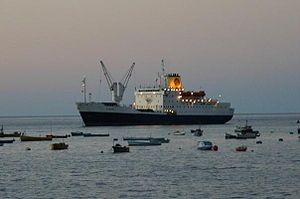
Cargo liner
Encyclopedia

Container ship
Container ships are cargo ships that carry all of their load in truck-size intermodal containers, in a technique called containerization. They form a common means of commercial intermodal freight transport.-History:...
s and other more specialized carriers in the latter half of the twentieth century.
Characteristics
A cargo liner has been defined as:A vessel which operated a regular scheduled service on a fixed route between designated ports and carries many consignments of different commodities.
Cargo liners transported general freight, from raw materials to manufacturers to merchandise. Many had cargo holds adapted to particular services, with refrigerator space for frozen meats or chilled fruit, tanks for liquid cargos such as plant oils, and lockers for valuables. Cargo liners typically carried passengers as well, usually in a single class. They differed from ocean liners which focussed on the passenger trade, and from tramp steamer
Tramp steamer
A ship engaged in the tramp trade is one which does not have a fixed schedule or published ports of call. As opposed to freight liners, tramp ships trade on the spot market with no fixed schedule or itinerary/ports-of-call...
s which did not operate on regular schedules. Cargo liners sailed from port to port along routes and on schedules published in advance.
History
The cargo liner developed in the mid nineteenth century with the advancement of technology allowing bigger steamships to be built. As cargo liners were generally faster than cargo shipCargo ship
A cargo ship or freighter is any sort of ship or vessel that carries cargo, goods, and materials from one port to another. Thousands of cargo carriers ply the world's seas and oceans each year; they handle the bulk of international trade...
s, they were used for the transport of perishable and high-value goods as well as providing a passenger service. At first, they were used in Europe and between Europe and America. Longer routes such as that to Australia
Australia
Australia , officially the Commonwealth of Australia, is a country in the Southern Hemisphere comprising the mainland of the Australian continent, the island of Tasmania, and numerous smaller islands in the Indian and Pacific Oceans. It is the world's sixth-largest country by total area...
remained in the hands of sailing ship
Sailing ship
The term sailing ship is now used to refer to any large wind-powered vessel. In technical terms, a ship was a sailing vessel with a specific rig of at least three masts, square rigged on all of them, making the sailing adjective redundant. In popular usage "ship" became associated with all large...
s due to the inefficiency of the steamship of the time.
The use and increased reliability of the compound steam engine gave greater fuel efficiency and opened these routes up to steamships. Alfred Holt pioneered the use of these engines in his steamships. It was now possible for a steamship to carry enough coal to travel 6000 miles (9,656 km) before needing to refuel. The opening of the Suez Canal
Suez Canal
The Suez Canal , also known by the nickname "The Highway to India", is an artificial sea-level waterway in Egypt, connecting the Mediterranean Sea and the Red Sea. Opened in November 1869 after 10 years of construction work, it allows water transportation between Europe and Asia without navigation...
in 1869 and the Panama Canal
Panama Canal
The Panama Canal is a ship canal in Panama that joins the Atlantic Ocean and the Pacific Ocean and is a key conduit for international maritime trade. Built from 1904 to 1914, the canal has seen annual traffic rise from about 1,000 ships early on to 14,702 vessels measuring a total of 309.6...
in 1914 also made the use of cargo liners more profitable, and made possible regular scheduled overseas services. Cargo liners soon comprised "the great portion of the British merchant fleet", the largest in the world.
The decline of the cargo liner came in the 1970s with the introduction of container ship
Container ship
Container ships are cargo ships that carry all of their load in truck-size intermodal containers, in a technique called containerization. They form a common means of commercial intermodal freight transport.-History:...
s. However, some cargo liners are still in service, such as the .

